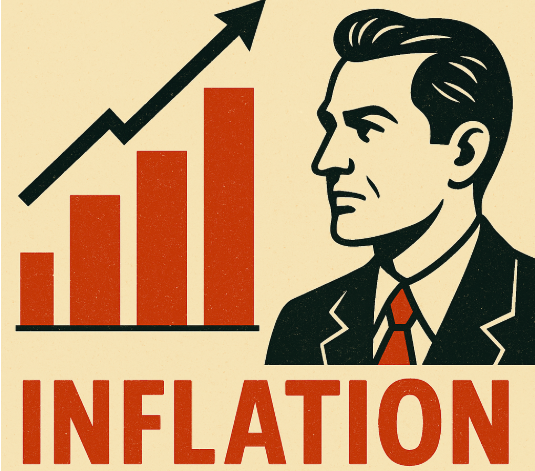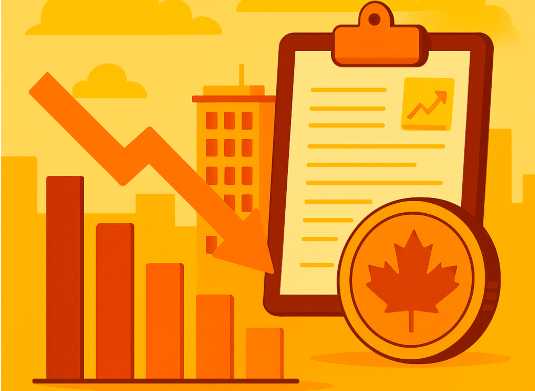Canada’s economy has shifted into a strange gear: not collapsing, not booming — just grinding. Inflation cooled, then ticked back up, and now everyone’s staring at the Bank of Canada wondering if the next move is a cut, a pause, or a politically unpopular hike nobody asked for.
Welcome to Canadian macro, 2025.
CPI: Cooling… But Not Cleanly
Inflation was supposed to be “done.” Then it wasn’t.
- Headline CPI recently bounced to ~2.4% YoY after drifting near 2%
- Core inflation measures (trim & median) are more stubborn around 2.6%–3%
- BoC’s target remains 2% flat
Translation: Inflation isn’t dead — it’s just pretending to behave.
Energy, groceries, and rent remain the recurring villains. The economy isn’t overheating — it’s just sticky.

Growth: Soft, Not Sick
GDP is crawling along at roughly 1.2%–1.3%, better than a recession, but only technically.
Big forces at play:
- Weak business investment
- Exports pressured by global slowdown
- Population growth masking underlying softness
This is like Canada running on vibes, immigration, and Tim Hortons caffeine.
What the Market Expects the BoC To Do
The BoC has two choices and hates both:
- Cut → risk reigniting inflation
- Hold → risk choking growth and households
So markets are pricing in a slow, cautious path:
- Maybe one more 25 bps cut near‑term
- No aggressive easing cycle unless something breaks
BoC is basically saying: “We want to cut, but inflation is still giving us side‑eye.”

Housing: Still the Economic Boss
Housing is still the heavyweight in Canada’s economy.
- Mortgage renewals + higher rates = household stress
- But lack of supply keeps prices sticky
Canadians aren’t selling — they’re sweating.
This keeps the BoC boxed in: relief cuts help households, but risk pumping housing all over again.
CAD & Investors
The Canadian dollar remains closely linked to macro drivers:
- BoC vs Fed policy gap: Canada sits roughly 25–50 bps below the Fed depending on the meeting cycle
- Oil prices: WTI has been fluctuating in the $70–$85 USD/barrel range, supporting CAD when strong and pressuring it when soft
- Capital flows & risk sentiment: CAD tends to benefit when markets move to risk‑on and weaken in risk‑off periods
Despite softer growth, CAD has remained relatively stable, recently trading in the USD/CAD 1.32–1.37 range. A sharper Fed‑BoC policy divergence or sustained commodity weakness could add downside pressure.
The Vibe Check
This isn’t doom. It isn’t boom. It’s slow‑burn monetary purgatory.
What could flip the script:
- Confirmed inflation downtrend → cuts accelerate
- Global slowdown → CAD weakens, BoC forced to support economy
- Housing stress cracks → emergency intervention risk
Labour Market: Cooling But Not Cracking
Canada’s job market hasn’t collapsed — but the steam is gone.
Key signals:
- Unemployment hovering near 6%, up from pandemic‑era lows
- Wage growth moderating but still sticky around 3%+
- Job vacancy rates down from peaks, hiring slower
- Productivity remains a national meme (still weak)
Employers aren’t firing en masse — they’re just not hiring aggressively. Think “soft chill, not ice age.”
If unemployment climbs into the 6.5%–7% range, that’s when the alarm bells ring and BoC pressure to cut intensifies.

Bank of Canada Playbook (How They Think)
When the Governing Council meets, they’re juggling three dials: inflation, jobs, and financial stability. Here’s the cheat sheet.
The Quick Rulebook
- Cut bias if: headline CPI trends toward 2% and core measures (trim/median) drift below ~2.5% while unemployment pushes 6.5%+ and growth underperforms.
- Hold bias if: CPI sits ~2–3%, core is sticky, jobs cool but don’t crack, and housing stress is manageable.
- Hike risk (low) only if: inflation re-accelerates (core >3% for several prints) and CAD/oil dynamics transmit into broader prices.
Decision Matrix (2025 vibe)
- Inflation down, jobs softening → one or two 25 bps cuts spaced out.
- Inflation sticky, growth soft → pause; lean on guidance, not action.
- Inflation re-firms, wages hot → no cuts; signal longer hold.
- Financial stress pops up (mortgage delinquencies, credit cracks) → policy support via liquidity tools first; cuts if disinflation continues.
What Moves the Odds Week-to-Week
- CPI (monthly): trim/median prints vs 2.5% line in the sand
- Labour: unemployment trend toward 6.5–7%, wage growth cooling
- Housing: payment shock data, arrears, resale volumes
- US spillovers: Fed path; USD/CAD and oil swings
- BoC language: watch words like “progress is broadening” (dovish) vs “inflation persistence” (hawkish)
Investor Translation
- Front-end bonds (1–3Y): benefit first on cut signals; curve steepening likely if growth sours
- Rate‑sensitives (REITs, utilities): relief if cuts priced; still earnings‑sensitive to growth
- Banks: prefer a gentle cut path; watch provisions for credit losses
- CAD: drifts with Fed‑BoC gap and oil; deeper cut odds = weaker CAD unless oil rallies
Bottom Line
Canada is in a holding pattern. Rates aren’t shooting higher, but the BoC isn’t racing to cut either. Inflation isn’t done fighting, but growth isn’t falling apart.
It’s a fragile balance — and investors should watch:
- CPI monthly prints (especially core)
- Labour market cooling trend
- Housing stress signs
- BoC vs Federal Reserve divergence
Right now, “slow & steady” is the BoC motto, but one shock could change everything.
Grab popcorn. And maybe hedge.
Marc has been involved in the Stock Market Media Industry for the last +5 years. After obtaining a college degree in engineering in France, he moved to Canada, where he created Money,eh?, a personal finance website.

